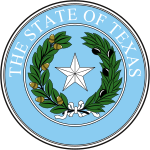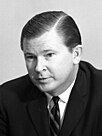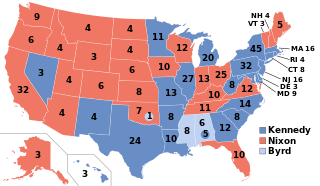
The 1960 United States presidential election was the 44th quadrennial presidential election. It was held on Tuesday, November 8, 1960. In a closely contested election, Democratic Senator John F. Kennedy defeated the incumbent Vice President Richard Nixon, the Republican nominee. This was the first election in which 50 states participated, marking the first participation of Alaska and Hawaii, and the last in which the District of Columbia did not. This made it the only presidential election where the threshold for victory was 269 electoral votes. It was also the first election in which an incumbent president –in this case, Dwight D. Eisenhower– was ineligible to run for a third term because of the term limits established by the 22nd Amendment.

The 1964 United States presidential election was the 45th quadrennial presidential election. It was held on Tuesday, November 3, 1964. Incumbent Democratic President Lyndon B. Johnson defeated Senator Barry Goldwater, the Republican nominee, in a landslide. Johnson was the fourth and most recent vice-president to ascend to the presidency following the death of his predecessor and to win a full term in his own right. With 61.1% of the popular vote, Lyndon B. Johnson won the largest share of the popular vote for the Democratic Party in history, and the highest for any candidate since the advent of widespread popular elections in the 1820s.

Lyndon Baines Johnson, often referred to by his initials LBJ, was an American politician who served as the 36th president of the United States from 1963 to 1969. He became president after the assassination of John F. Kennedy, under whom he had served as the 37th vice president from 1961 to 1963. A Democrat from Texas, Johnson also served as a U.S. representative and U.S. senator.

Ralph Webster Yarborough was an American politician and lawyer. He was a Texas Democratic politician who served in the United States Senate from 1957 to 1971 and was a leader of the progressive wing of his party. Along with Senate Majority Leader Lyndon B. Johnson and Speaker of the House Sam Rayburn, but unlike most Southern congressmen, Yarborough refused to support the 1956 Southern Manifesto, which called for resistance to the racial integration of schools and other public places. Yarborough voted in favor of the Civil Rights Acts of 1957, 1960, 1964, and 1968, as well as the 24th Amendment to the U.S. Constitution, the Voting Rights Act of 1965, and the confirmation of Thurgood Marshall to the U.S. Supreme Court. Yarborough was the only senator from a state that was part of the Confederacy to vote for all five bills.
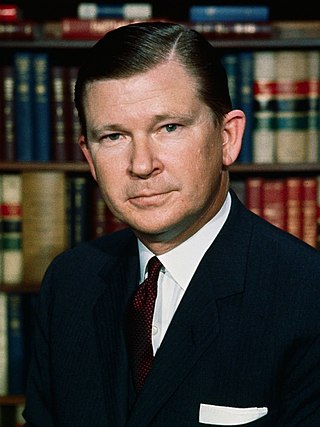
John Goodwin Tower was an American politician and military officer who represented Texas in the United States Senate from 1961 to 1985. He was the first Republican elected to the U.S. Senate from Texas since Reconstruction. Tower is known for leading the Tower Commission, which investigated the Iran-Contra Affair in the Reagan administration.

Thomas LeRoy Collins was an American politician who served as the 33rd governor of Florida from 1955 to 1961. Collins began his governorship after winning a special election in 1954, and was elected to a four-year term in 1956.

The 1964 United States Senate elections were held on November 3. The 33 seats of Class 1 were contested in regular elections. Special elections were also held to fill vacancies. They coincided with the election of President Lyndon B. Johnson by an overwhelming majority, to a full term. His Democratic Party picked up a net two seats from the Republicans. As of 2023, this was the last time either party has had a two-thirds majority in the Senate, which would have hypothetically allowed the Senate Democrats to override a veto, propose constitutional amendments, or convict and expel certain officials without any votes from Senate Republicans. In practice, however, internal divisions effectively prevented the Democrats from doing so. The Senate election cycle coincided with Democratic gains in the House in the same year.

The 1960 United States Senate elections coincided with the election of John F. Kennedy as president on November 8, 1960. The 33 seats of Class 2 were contested in regular elections. A special election was also held on June 28, 1960, for a mid-term vacancy in North Dakota where Democrats flipped a seat to expand their majority to 66–34. As Majority Leader Lyndon Johnson was elected Vice President, Mike Mansfield became the new majority leader.
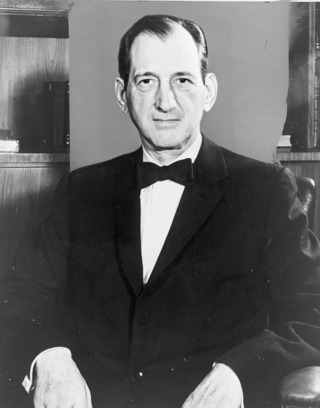
William Arvis "Dollar Bill" Blakley was an American politician and businessman from the state of Texas. Blakley was part of the conservative wing of the Texas Democratic Party. He served twice as an interim United States Senator, appointed by the Governor to fill a vacancy until his successor could be duly elected. He served first in 1957 after the resignation of Price Daniel and again in 1961 after the resignation of Lyndon B. Johnson.

Lyndon Baines Johnson Day is a legal state holiday in Texas. It falls every year on August 27, to mark the birthday of U.S. President Lyndon Baines Johnson.

The 1960 Democratic National Convention was held in Los Angeles, California, on July 11–15, 1960. It nominated Senator John F. Kennedy of Massachusetts for president and Senate Majority Leader Lyndon B. Johnson of Texas for vice president.
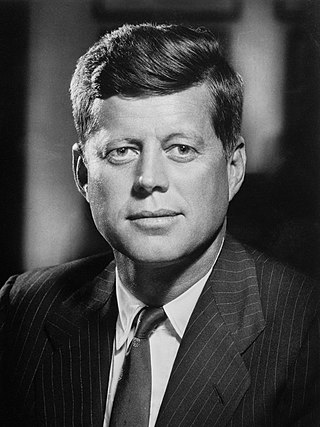
From March 8 to June 7, 1960, voters and members of the Democratic Party elected delegates to the 1960 Democratic National Convention through a series of caucuses, conventions, and primaries, partly for the purpose of nominating a candidate for President of the United States in the 1960 election. The presidential primaries were inconclusive, as several of the leading contenders did not enter them, but U.S. Senator John F. Kennedy of Massachusetts emerged as the strongest candidate and won the nomination over Lyndon B. Johnson at the convention, held from July 11 to 15 at the Los Angeles Memorial Sports Arena.

Electoral history of Lyndon B. Johnson, who served as the 36th president of the United States (1963–1969), the 37th vice president (1961–1963); and as a United States senator (1949–1961) and United States representative (1937–1949) from Texas.
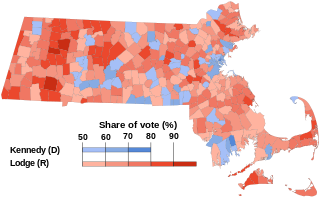
The 1952 United States Senate election in Massachusetts was held on November 4, 1952, in which Incumbent Republican Henry Cabot Lodge Jr. lost to Congressman and future President John F. Kennedy, the Democratic Party nominee.
Thaddeus Thomson Hutcheson, was a Republican attorney in his native Houston, who was an early figure in the movement to establish a competitive two-party system in the U.S. state of Texas.

The selection of the Democratic Party's vice presidential candidate for the 1960 United States presidential election occurred at the party's national convention on August 13, 1960. After winning the presidential nomination on the first ballot of the 1960 Democratic National Convention, Massachusetts Senator John F. Kennedy turned his attention to picking a running mate. Kennedy chose Senate Majority Leader Lyndon B. Johnson, who had finished second on the presidential ballot, as his running mate. Johnson, a Protestant Texan, provided geographical and religious balance to a ticket led by a Catholic Northeasterner, but many liberals did not like the pick. Many were surprised both that Kennedy made the offer and that Johnson accepted the offer, as the two had been rivals for the 1960 presidential nomination. According to some accounts, Kennedy had offered the position to Johnson as a courtesy and expected Johnson to decline the offer; when Johnson accepted, Kennedy sent his brother, Robert F. Kennedy, to talk Johnson out of accepting the offer. However, Kennedy may have made the offer in earnest due to Johnson's appeal in the south, Johnson's friendly relationship with Speaker of the House Sam Rayburn, and Kennedy's desire to remove Johnson as Senate Majority Leader in favor of the more liberal Mike Mansfield. Regardless, Johnson decided that accepting the offer would be better for his political career and better position himself to become president, and so he chose to become Kennedy's running mate. The Democratic convention confirmed Johnson as the vice presidential nominee, although the delegation from Washington, D.C. attempted to select Minnesota Governor Orville Freeman instead.

The 1957 United States Senate special election in Texas was held on April 2, 1957, to complete the unexpired term of Senator Price Daniel, who resigned to become Governor of Texas. Interim Senator William Blakley did not run for re-election. Ralph Yarborough won the race with a plurality of the vote; no majority was required.

The 1960 United States presidential election in Wyoming took place on November 8, 1960, as part of the 1960 United States presidential election. State voters chose three representatives, or electors, to the Electoral College, who voted for president and vice president.

Homa Jackson Porter, usually known as H. J. Porter or Jack Porter was a Texas businessman and political activist. A key figure in building a competitive Republican Party in his home state after a century of Democratic dominance, Porter was best known as Lyndon Johnson's general election opponent in the 1948 contest for a seat in the United States Senate.
The 1964 presidential campaign of Lyndon B. Johnson was a successful campaign for Johnson and his running mate Hubert Humphrey for their election as president and vice president of the United States. They defeated Republican presidential nominee Barry Goldwater and vice presidential nominee William Miller. Johnson, a Democrat and former vice president under John F. Kennedy was inaugurated as president upon Kennedy's assassination. In 1964, Johnson did not look optimistically upon the prospect of being elected president in his own right. Despite Johnson's uncertainty about running, he was seen as the most likely candidate to get the nomination. He entered the primaries starting with New Hampshire and won the state by almost 29,000 votes. Johnson's main opponent in the primaries was Alabama Governor George Wallace, who had announced his intention to seek the presidency even before Kennedy's assassination.
